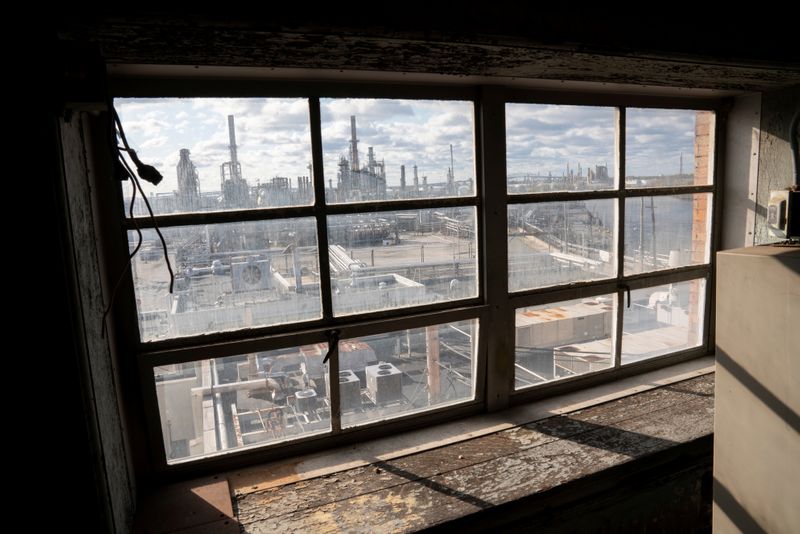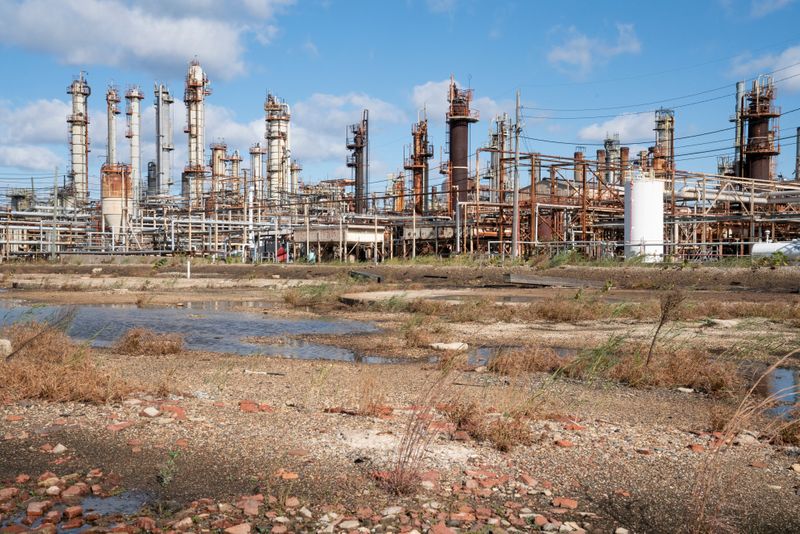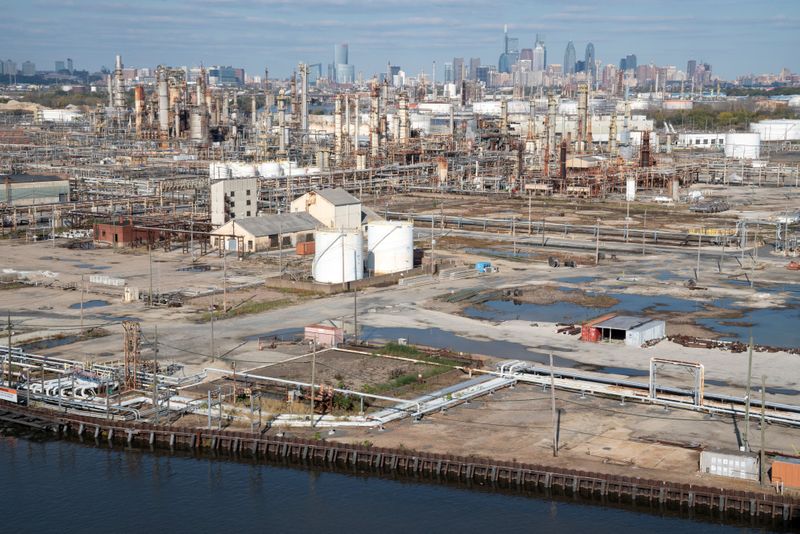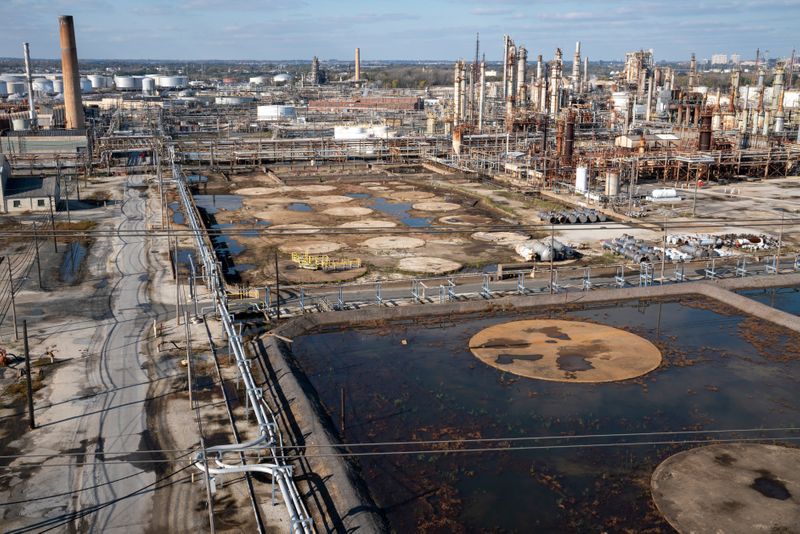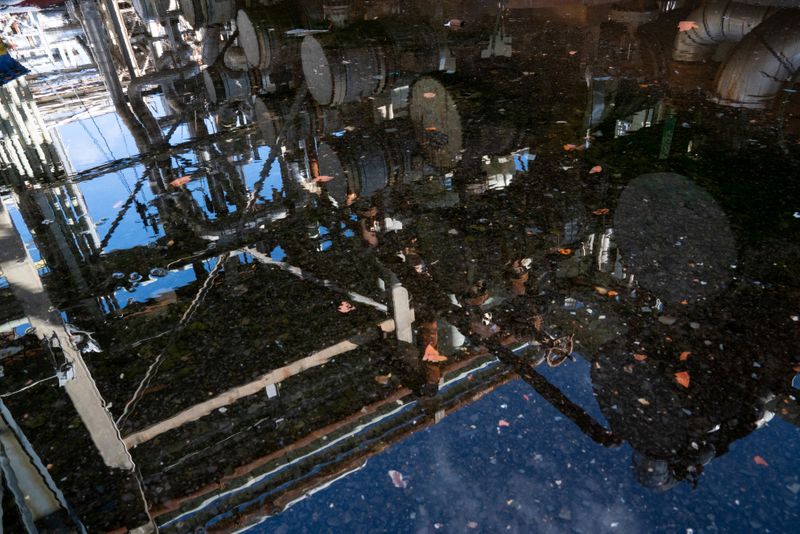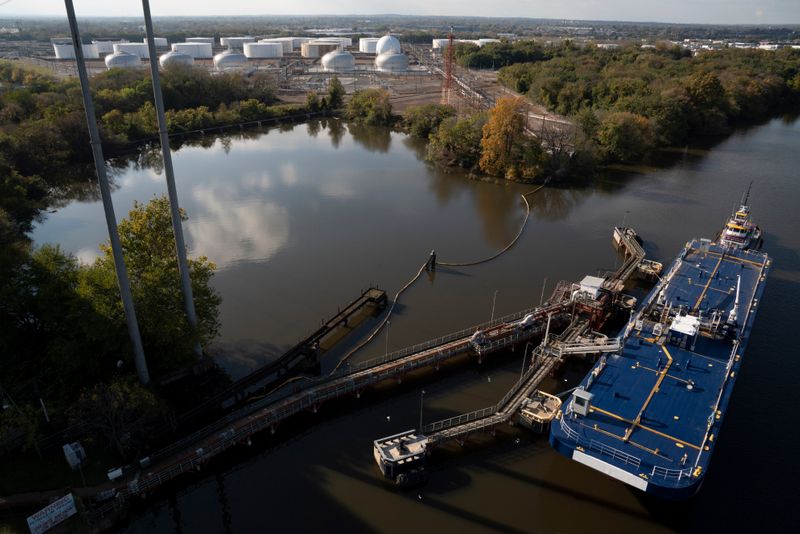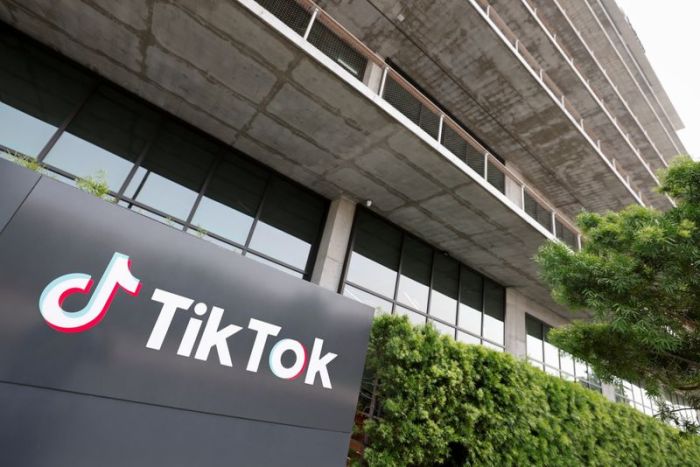PHILADELPHIA (Reuters) – Wearing blue hard hats, white hazmat suits and respirator masks, workers carted away bags of debris on a recent morning from a sprawling and now-defunct oil refinery once operated by Philadelphia Energy Solutions (PES).
Other laborers ripped asbestos from the guts of an old boiler house, part of a massive demolition and redevelopment of the plant, which closed in 2019 after a series of explosions at the facility.
Plans call for the nearly 1,400-acre site to be transformed into a new commercial hub with warehousing and offices. All it will take is a decade, hundreds of millions of dollars, and confronting 150 years’ worth of industrial pollution, including buried rail cars and a poisonous stew of waste fuels poured onto the ground. A U.S. refinery cleanup of this size and scope has no known precedent, remediation experts said.
It’s a glimpse of what lies ahead if the United States hopes to wean itself off fossil fuels and clean up the toxic legacy of oil, gas and coal.
President Joe Biden wants to bring the United States to net-zero greenhouse gas emissions by 2050 to fight climate change through a shift to clean-energy technologies, while reducing pollution in low-income and minority neighborhoods near industrial facilities.
It’s a transition fraught with challenges. Among the biggest is what to do with the detritus left behind. The old PES plant is just one of approximately 135 oil refineries nationwide, to say nothing of the country’s countless gas stations, pipelines, storage hubs, drill pads and other graying energy infrastructure.
In recent months, at least six other large U.S. oil refineries – from New Jersey to California – have announced they will close or cease oil refining as the coronavirus pandemic has sapped global fuel demand.
“The energy transition will require massive attention to both new infrastructure and addressing aging or outdated systems,” said Morgan Bazilian, director of the Payne School of Public Policy at the Colorado School of Mines.
In Philadelphia, a private-sector company is taking the lead. Hilco Redevelopment Partners, a real estate firm that specializes in renovating old industrial properties, bought the PES refinery out of bankruptcy for $225.5 million in June.
Asbestos abatement alone will require four years to complete, said Roberto Perez, chief executive of the Chicago-based company.
“There’s enough pipeline to connect you from here to Florida, and the majority of that pipeline today is wrapped in asbestos,” Perez said.
The full extent of the pollution won’t be understood for years. Also uncertain is the ability of the refinery’s previous owners to pay their share of the cleanup. The facility has had multiple owners over its lifetime and responsibility has been divided between them through business agreements and legal settlements.
A lot is riding on the outcome. Transformation of the refinery, the oldest and largest on the U.S. East Coast, could bring jobs to a low-income, racially diverse neighborhood that needs them.
But residents also want a say in how the work proceeds after enduring the brunt of the refinery’s pollution. Some complained about feeling shut out of the process during a recent virtual public meeting organized by companies involved in the cleanup.
The refinery’s previous owner, Sunoco Inc, had gone years without holding city-mandated public meetings about pollution at the site.
Evergreen Resources Group, LLC, a subsidiary of Sunoco’s parent company, Energy Transfer LP, which is in charge of managing a share of the cleanup, declined to comment on the lapse in meetings. It pointed to a website it launched last year to engage with the public about the project.
Hilco’s Perez has no illusions about the work ahead.
“This is a very heavy lift,” he said. “It’s probably one of the most complicated things I’ve ever done.”
SURPRISES IN A TOXIC SOUP
Oil refining at the Philadelphia site began in 1870, 100 years before the creation of the U.S. Environmental Protection Agency (EPA). Gasoline, once a worthless byproduct of heating oil, was routinely dumped by the refinery into the soil, according to historians and researchers. Leaks and accidents spewed more toxins. The June 2019 blasts alone released 676,000 pounds of hydrocarbons, PES said at the time.
The Philadelphia site is not unique. About half of America’s 450,000 polluted former industrial and commercial sites are contaminated with petroleum, according to the EPA.
“That’s one of the reasons that a lot of these refineries have been kept going for such a long time,” said Fred Quivik, a Minnesota-based industrial historian. “They’re so contaminated, it’s hard to figure out what else to do with them.”
Cleanup in Philadelphia will be painstaking. After asbestos abatement comes the demolition and removal of 3,000 tanks and vessels, along with more than 100 buildings and other infrastructure, the company said.
Then comes the ground itself. Hilco’s Perez said dirt quality varies widely on the site and will have to be handled differently depending on contamination levels. Clearing toxins like lead must be done with chemical rinses or other technologies, said Charles Haas, professor of environmental engineering at Drexel University in Philadelphia.
The site also has polluted groundwater and giant benzene pools lurking underneath, according to environmental reports Sunoco filed over the years with the federal and state governments.
Perez, Hilco’s chief executive, said clean energy will be a centerpiece of the final project. The warehouse complex, for example, will aim to feature charging stations for a fleet of electric delivery vehicles, he said.
The company is also considering a hotel, residential homes, and a restaurant on the site, two people familiar with the plans said.
The project is expected to take 10 to 15 years to finish. Cleanup and construction are projected to create about 13,000 jobs, the company said, with another 19,000 jobs tied to warehousing, offices and transporting goods.
PICKING UP THE BILL
The final price tag is unclear.
The development’s fate hinges on previous polluters paying their fair share. The site, founded by the Atlantic Refining Company, later known as ARCO, has cycled through several owners.
Sunoco, which owned the refinery for about two decades, sold its majority stake in 2012 to Carlyle Group Inc, which later formed PES. That deal stipulated that Sunoco assume all environmental liabilities dating to the plant’s inception in the 1800s. Energy Transfer, which bought Sunoco the same year as the refinery sale, now shoulders that burden.
Dallas-based Energy Transfer has $205 million in insurance to cover all of Sunoco’s decommissioned sites, including PES, according to the company’s filings with the Securities and Exchange Commission.
Amanda Goodin, a lawyer with the environmental group Earthjustice who has litigated major environmental cleanup cases, said comparable projects, such as clearing shuttered mining operations, can run into the billions of dollars.
“These cleanups are just enormously expensive, and companies basically never set aside enough money to fully remediate a site,” Goodin said.
Energy Transfer would not say how much it expects its share of the PES refinery cleanup to cost, but spokeswoman Vicki Granado said it is “fully funded”.
Hilco, as part of its 2020 purchase of PES, assumed liabilities tied to the last eight years of the refinery’s life, a tab it estimates will amount to “hundreds of millions” of dollars. The company declined to be more specific, but said it believes it has the funds for the job.
The Pennsylvania Department of Environmental Protection said it has consent orders against Sunoco and Hilco that enable the regulator to sue the companies if they attempt to walk away, spokeswoman Virginia Cain said.
ENVIRONMENTAL JUSTICE
Abdul Muhammad, 34, who lives near the Philadelphia refinery, says life has improved since it shut down. His asthmatic baby son now sleeps through the night, while his wife’s chronic headaches have become less frequent.
“I just don’t want chemicals and environmentally contaminated things going in and out of there,” he said of his wishes for the site.
Philly Thrive, a community activist group, has been pressuring Hilco and city officials to ensure that neighborhood residents have a say in the cleanup and redevelopment.
Some of their hopes rest with the Biden administration, which has committed to direct 40% of any federal clean-energy investment to communities most impacted by industrial pollution.
But whether climate legislation emerges from a divided Congress remains to be seen.
Philadelphia officials hope PES can become a model for refinery cleanups elsewhere. Kenyatta Johnson, a city councilman who represents neighborhoods surrounding the facility, sees a healthy, more prosperous community emerging from its toxic shadow.
“Some may deem the site a health hazard and eyesore, but nevertheless it’s an opportunity,” Johnson said.
(Reporting by Laila Kearney Philadelphia and Valerie Volcovici in Washington; additional reporting by Dane Rhys in Philadelphia; Editing by Richard Valdmanis, Brian Thevenot and Marla Dickerson)

